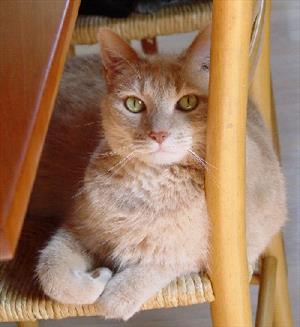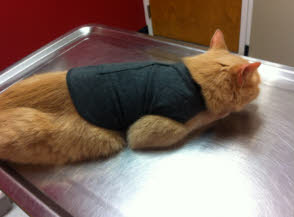
Whether your cat’s as shy in public as a student with stage fright, or enjoys being the center of attention, chances are still good that a trip to the veterinary hospital has him retreating into his shell. According to the Bayer veterinary care usage study funded by Bayer HealthCare LLC, Animal Health Division, fear and stress prompt 39% of owners to take their cats to the vet hospital only in cases of emergencies, and 37.6% of owners feel stressed just thinking about going to the vet.
This fear of veterinary visits can be prevented early on by proactively providing kittens with many positive experiences at the hospital, in the pet carrier and in the car ride before. For adult cats, reversing negative experiences that may have already occurred can be a little trickier and may require a combination of behavior modification, plus pheromone therapy (Feliway®), as well as other tools. In fact, one tool you might consider is a Thundershirt® Compression Wrap for Cats.
Now, I have tried the Thundershirt® on cats only to have them flop on their sides as if they think they are suddenly immobilized. However, in some cases, the Thundershirt® can have a clear positive effect and the effects are quick. Take the case reported by colleague Janet Velenovsky of Kaizen Pet Training & Behavior.
Says Velenovsky, a Karen Pryor Academy trainer, who presented the case at the 2013 ACVB/AVSAB Veterinary Behavior Symposium in Chicago Ill, “Griffin is a 16-year-old neutered male cat with a history of stressful reactions to veterinary visits. He’d urinate in his crate and vocalize continuously during the car ride. His veterinarian, Dr. Sue Atkins of Manakin-Sabot Veterinary Clinic, reported that over the last ten years, Griffin routinely had a rapid heart rate during examination and was difficult to handle for blood draws and other procedures.”
Not surprisingly this stress extended beyond his visit. His owner also reported that he’d avoid her and hide immediately upon return home.
Generally, one would tackle this type of case by first training Griffin to love his carrier, which can take as little as a few days, and to love car rides, which is less convenient to practice. This would be followed with pairing non-treatment visits (sometimes called Happy Visits) to the vet with good things such as treats. Pheromones such as Feliway®, as well as neutraceuticals such as Anxitane, might be added with the understanding that they may or may not help. Velenovsky wanted to test use of the Thundershirt® for cats all by itself.
Griffin’s Behavior Improves at the Veterinary Hospital
Velenosky approached the situation in a methodical manner so that she could objectively assess whether the Thundershirt® was beneficial or not. She gathered data on prior visits from the owners and referring veterinarian and then collected the same information following use of the product. The results were resoundingly positive. Griffin’s owner noticed the positive results immediately. She reported a 90% reduction in vocalization during the 30 minute car ride where in the past he’d vocalized continuously. She also noted that although Griffin urinated on his first car trip while wearing the compression wrap, he did not urinate in the carrier during his second trip, even though her veterinarian confirmed that he had a full bladder.
Griffin’s veterinarian saw a clear change too. She reported heart rate in a normal range (150) rather than the elevated level noted at all previous clinic visits (210+), and she noted a lack of sweaty paws. She also reported an improvement in ability to hear his known heart murmur; when cats are nervous, they sometimes purr or struggle and breath rapidly, making heart sounds more difficult to hear. Veterinary staff reported at least 50% improvement in their ability to handle Griffin while shaving and preparing a spot for a blood draw. They were even able to accomplish the blood draw from his front leg without restraint. In the past if they tried to take blood from the front leg, Griffin would yank his leg back and they would have to restrain him more firmly so blood could be taken from his hind legs.
Were Improvements Due to Immobilization or to Decreased Anxiety?
One could surmise that Griffin’s better behavior was just due to being immobilized, in which case he could actually be more stressed; however, a number of factors indicate that he behaved better because his anxiety was decreased. For one, the low heart rate and lack of urination in the crate supports the likelihood that the improvement in behavior was due to decreased anxiety. Furthermore, the owner reported Griffin interacted calmly within minutes of his release from the carrier at home, and showed none of his usual post-trip behaviors where he would hiss, run away and hide upstairs, and skip at least one meal.
The take home message here is that the Thundershirt® for Cats can offer immediate anxiety relief in some cats. In order to determine whether it’s working and whether it’s causing a decrease in anxiety, one should evaluate for changes in anxiety behavior objectively—such as:
- by measuring heart rate
- checking for sweaty paws
- looking for other behavioral signs of anxiety such as vocalizing, urinating, hissing, willingness to eat treats
- noting the amount of struggling during procedures
- observing the cat’s demeanor once it gets home — does he hide and show signs of agitation or does the cat again behave like his normal self?
Best to Combine the Thundershirt with Other Tools
As always, expect to get the best results when you combine the Thundershirt® with other approved stress-decreasing methods. For instance, owners can pair it with treats. The compression wrap could decrease the cat’s anxiety enough such that your cat, if hungry, might be willing to eat treats, which would further improve the positive experience. The veterinary staff should combine its use with low stress handling techniques (www.lowstresshandling.com) such as towel wrap techniques which can keep the cat feeling comfortable and safe, as well as by setting up a cat-friendly hospital environment.
By considering each patient’s needs and objectively assessing the situation, as illustrated by Velenovsky and Griffin, we can help cats have happier veterinary visits and hence experience less stressful, more thorough veterinary care.






